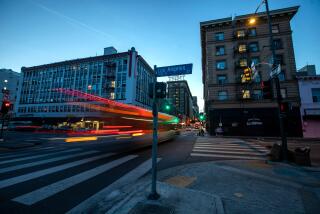Ecology Group Going for the Green at Headquarters
- Share via
ANNAPOLIS, Md. — When the Chesapeake Bay Foundation moves into its new headquarters later this year, employees will use flushless toilets and wash their hands in unheated rainwater.
A system of computerized red and green lights will tell them when, in the interest of energy efficiency, they should open and close windows. Photo sensors will turn off the lights when there is enough natural light shining through the glass walls looking out over the Chesapeake Bay.
Rain that runs off the parking lot will be routed through two filtering systems and wetlands before entering the bay, at which time it is supposed to be pure enough to drink.
Those are a few of the features incorporated in what foundation officials think will be one of the “greenest” office buildings ever built.
Chuck Foster, director of fleets and facilities for the foundation, said environmental criteria guided every decision, from the selection of building materials and office furniture, to landscaping, to the height of outdoor lighting, which is low to reduce the impact on birds at night.
“Every building material was looked at” with environmental questions in mind, Foster said.
What was the recyclable content? How long was the life cycle? How far would materials be transported from the manufacturing site to the construction site? How much packing material would be used?
And, looking far into the future, the final question: “When it dies, can it be made into something useful again?” Foster said.
The Chesapeake Bay Foundation, an environmental group that works to restore the health of the bay, has offices scattered in several locations around Annapolis. It spent several years looking for a site for a new headquarters.
It settled on a 33-acre tract on the Chesapeake Bay in the community of Bay Ridge at the mouth of the Severn River, a few miles from downtown Annapolis. A $7.5-million gift from Philip Merrill, publisher of Washingtonian Magazine, The (Annapolis) Capital and four other newspapers, provided the major funding.
The property had been a public beach and banquet facility for many years, but the owner closed it and planned to sell lots for high-end housing. Bay Ridge residents approached the foundation about buying the property.
The decision drew mild criticism from people who thought the foundation was not being true to its principles by moving out of town into a residential community.
“I would have liked to see them stay in town. There is bus service. We have a variety of places for lunch,” Annapolis Mayor Dean Johnson said. “Where they are moving, they’ll have to get into an automobile simply to go to lunch.”
Geoff Oxnam, spokesman for the bay foundation, said the decision was environmentally sound.
The property is located in a priority funding area under Gov. Parris Glendening’s “smart growth” program, and was already developed with a large swimming pool and several buildings.
“We built on the footprint of the existing facility,” Oxnam said.
The foundation will be restoring wetlands and marshes and improving wildlife habitat, he said.
Tom Eichbaum, partner in Smith Group Architects, which designed the building, said residential development would have had a more negative impact on the environment than its use by the foundation.
Eichbaum said it was fun to design what he called “this wonderful puzzle that is slowly emerging.”
One example of an environmentally friendly design element: using cork flooring throughout most of the building instead of carpeting, even though carpeting would have cost less. Cork is quiet, is a warm color and does not give off harmful gases as does some carpet. Plus, it is a renewable resource, Eichbaum said.
“You harvest cork and the tree remains alive. You’re not destroying a forest,” he said.
The designers used wood from pickle barrels salvaged by Foster to build sun screens to reduce heat from the summer sun but allow sun to help heat the building in winter.
They used galvanized siding for the exterior walls. Foster said the siding has a high recyclable content, requires little maintenance, is manufactured within 300 miles of the site and “is flat and required minimal packaging.”
Energy use got a lot of attention.
About one-third of the energy will come from renewable sources, including solar panels to heat water for showers and laundry and geothermal heat pumps operating in 300-foot deep wells to assist in heating and cooling the building.
Foster estimates the building will use about one-third as much energy from conventional sources as a traditional office building.
Those flushless toilets, with wastes going directly into composting bins, will contribute to large reductions in water use. Foster estimates the building will use only about 10% as much water from wells or public water supplies as a conventional building.
All this environmental concern does not come cheap.
The costs will be around $200 a square foot, considerably more than a standard building but “not too far out of line with a very high-end building,” Foster said.
More to Read
Sign up for Essential California
The most important California stories and recommendations in your inbox every morning.
You may occasionally receive promotional content from the Los Angeles Times.











